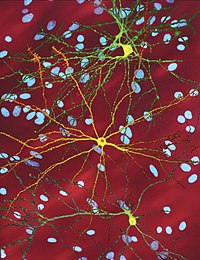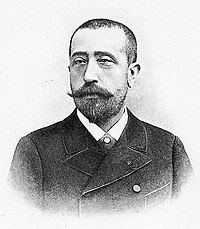
Treatment Responsiveness of Parkinsonism in Atypical Pantothenate Kinase‐Associated Neurodegeneration
Sign Up to like & getrecommendations! Published in 2020 at "Movement Disorders Clinical Practice"
DOI: 10.1002/mdc3.13056
Abstract: Pantothenate kinase-associated neurodegeneration (PKAN) is a rare progressive autosomal recessive disease caused by mutations in the PANK2 gene. PANK2 encodes a pantothenate kinase, an enzyme involved in coenzyme A production. The clinical presentation of PKAN… read more here.
Keywords: pantothenate kinase; pkan; kinase associated; associated neurodegeneration ... See more keywords

Clinical rating scale for pantothenate kinase‐associated neurodegeneration: A pilot study
Sign Up to like & getrecommendations! Published in 2017 at "Movement Disorders"
DOI: 10.1002/mds.27129
Abstract: Pantothenate kinase‐associated neurodegeneration is a progressive neurological disorder occurring in both childhood and adulthood. The objective of this study was to design and pilot‐test a disease‐specific clinical rating scale for the assessment of patients with… read more here.
Keywords: pantothenate kinase; clinical rating; kinase associated; associated neurodegeneration ... See more keywords

Clinical course of patients with pantothenate kinase-associated neurodegeneration (PKAN) before and after DBS surgery
Sign Up to like & getrecommendations! Published in 2019 at "Journal of Neurology"
DOI: 10.1007/s00415-019-09499-3
Abstract: Pantothenate kinase-associated neurodegeneration (PKAN) is a rare autosomal recessive disorder with a progressive clinical course. In addition to symptomatic therapy, DBS has been increasingly recognized as a potential therapeutic strategy, especially in severe cases. Therefore,… read more here.
Keywords: improvement; pantothenate kinase; pkan; dbs ... See more keywords

Overexpressing low-density lipoprotein receptor reduces tau-associated neurodegeneration in relation to apoE-linked mechanisms
Sign Up to like & getrecommendations! Published in 2021 at "Neuron"
DOI: 10.1016/j.neuron.2021.05.034
Abstract: APOE is the strongest genetic risk factor for late-onset Alzheimer's disease. ApoE exacerbates tau-associated neurodegeneration by driving microglial activation. However, how apoE regulates microglial activation and whether targeting apoE is therapeutically beneficial in tauopathy is… read more here.
Keywords: apoe; neurodegeneration; tau associated; activation ... See more keywords

Twin‐sisters with PLA2G6‐associated neurodegeneration due to paternal isodisomy of the chromosome 22 following in vitro fertilization
Sign Up to like & getrecommendations! Published in 2017 at "Clinical Genetics"
DOI: 10.1111/cge.12925
Abstract: Neurodegeneration with brain iron accumulation (NBIA) is a heterogeneous group of inherited neurodegenerative disorders of childhood characterized by progressive movement disorders and abnormal accumulation of iron in the basal ganglia. Among the NBIA genes, PLA2G6-associated… read more here.
Keywords: vitro fertilization; pla2g6 associated; neurodegeneration; plan ... See more keywords

Cannabis Use in Children With Pantothenate Kinase–Associated Neurodegeneration
Sign Up to like & getrecommendations! Published in 2019 at "Journal of Child Neurology"
DOI: 10.1177/0883073819890516
Abstract: Background: Pantothenate kinase–associated neurodegeneration is characterized by severe, progressive dystonia. This study aims to describe the reported usage of cannabis products among children with pantothenate kinase–associated neurodegeneration. Methods: A cross-sectional, 37-item survey was distributed in… read more here.
Keywords: cannabis; pantothenate kinase; kinase associated; associated neurodegeneration ... See more keywords

A new TAO kinase inhibitor reduces tau phosphorylation at sites associated with neurodegeneration in human tauopathies
Sign Up to like & getrecommendations! Published in 2018 at "Acta Neuropathologica Communications"
DOI: 10.1186/s40478-018-0539-8
Abstract: In Alzheimer’s disease (AD) and related tauopathies, the microtubule-associated protein tau is highly phosphorylated and aggregates to form neurofibrillary tangles that are characteristic of these neurodegenerative diseases. Our previous work has demonstrated that the thousand-and-one… read more here.
Keywords: inhibitor; associated neurodegeneration; tau phosphorylation; brain ... See more keywords

MED13 and glycolysis are conserved modifiers of α-synuclein-associated neurodegeneration.
Sign Up to like & getrecommendations! Published in 2022 at "Cell reports"
DOI: 10.2139/ssrn.4083382
Abstract: α-Synuclein (α-syn) is important in synucleinopathies such as Parkinson's disease (PD). While genome-wide association studies (GWASs) of synucleinopathies have identified many risk loci, the underlying genes have not been shown for most loci. Using Drosophila,… read more here.
Keywords: modifiers synuclein; med13; med13 glycolysis; neurodegeneration ... See more keywords

Expanding the Spectrum of Early Neuroradiologic Findings in β Propeller Protein-Associated Neurodegeneration
Sign Up to like & getrecommendations! Published in 2022 at "American Journal of Neuroradiology"
DOI: 10.3174/ajnr.a7693
Abstract: BACKGROUND AND PURPOSE: β propeller protein-associated neurodegeneration (BPAN) is the most common neurodegeneration with brain iron accumulation disorder. Typical radiologic findings are T2 hypointensity in the substantia nigra and globus pallidus, as well as a… read more here.
Keywords: substantia nigra; protein associated; propeller protein; neurodegeneration ... See more keywords

New Insights of Phospholipase A2 Associated Neurodegeneration Phenotype Based on the Long-Term Follow-Up of a Large Hungarian Family
Sign Up to like & getrecommendations! Published in 2021 at "Frontiers in Genetics"
DOI: 10.3389/fgene.2021.628904
Abstract: Introduction Phospholipase A2-associated Neurodegeneration (PLAN) is a group of neurodegenerative diseases associated with the alterations of PLA2G6. Some phenotype-genotype association are well known but there is no clear explanation why some cases can be classified… read more here.
Keywords: phospholipase associated; long term; family; associated neurodegeneration ... See more keywords

Typical pantothenate kinase-associated neurodegeneration caused by compound heterozygous mutations in PANK2 gene in a Chinese patient: a case report and literature review
Sign Up to like & getrecommendations! Published in 2023 at "Frontiers in Neurology"
DOI: 10.3389/fneur.2023.1170557
Abstract: Pantothenate kinase-associated neurodegeneration (PKAN) is a rare genetic neurodegenerative disorder with brain iron accumulation characterized as dysarthria, spasticity, cognitive impairment, parkinsonism, and retinopathy. PKAN is caused by biallelic mutations in the mitochondrial pantothenate kinase 2… read more here.
Keywords: associated neurodegeneration; pank2 gene; pantothenate kinase; kinase associated ... See more keywords